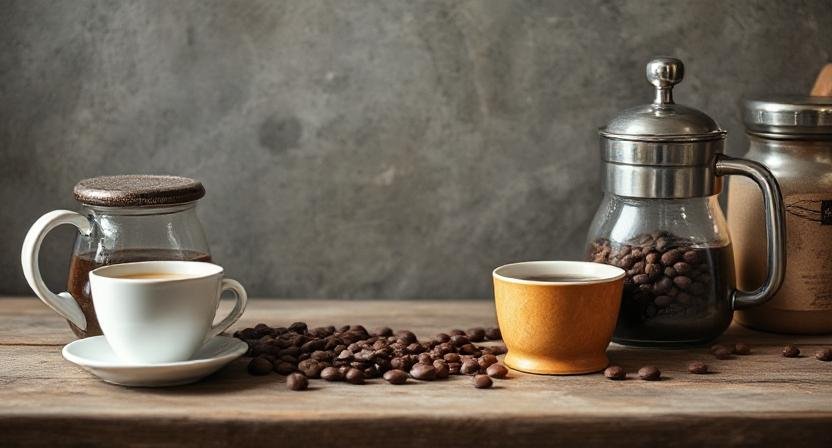If you’re a coffee lover and haven’t tried Vietnamese Egg Coffee (Cà Phê Trứng) yet, you’re missing out on one of the most indulgent and surprisingly simple coffee drinks in the world. Born in Hanoi in the 1940s, this creamy, custard-like coffee was created out of necessity when milk was scarce—and has since become a treasured Vietnamese specialty. In this guide, I’ll walk you through how to make authentic Vietnamese egg coffee at home, using everyday ingredients. It’s easier than you think—and honestly, it might just become your new favorite cozy drink.
What Is Vietnamese Egg Coffee?

Vietnamese Egg Coffee is a rich combination of strong Vietnamese coffee topped with a thick, frothy layer of whipped egg yolk, sugar, and sweetened condensed milk. The result is a beautifully layered cup that tastes like dessert meets espresso—bold, creamy, and slightly caramelized.
Fun Fact:
This drink was invented by Nguyen Van Giang, a bartender at Hanoi’s Metropole Hotel, during the milk shortage in post-war Vietnam. Instead of milk, he whipped egg yolks into a substitute—and the rest is history.
Ingredients You’ll Need
Here’s the good news: You probably have most of these ingredients in your kitchen already. For the most authentic result, though, I highly recommend using Vietnamese robusta coffee.
For 1 Serving:
2 tablespoons ground Vietnamese coffee (e.g., Trung Nguyên or Nguyen Coffee Supply)
1 egg yolk (fresh, organic if possible)
2 teaspoons sweetened condensed milk
1 teaspoon granulated sugar
Hot water
Tools:
Vietnamese phin filter (or French press/aeropress as an alternative)
Electric hand mixer or whisk
Heatproof serving glass
Step-by-Step: How to Make Vietnamese Egg Coffee

Step 1: Brew the Coffee
Start by brewing strong Vietnamese coffee using a traditional phin filter.
To brew using a phin:
Add 2 tablespoons of coffee into the filter.
Press down gently with the metal press.
Pour a bit of hot water to bloom the grounds (wait 20 seconds).
Fill the filter with hot water and let it drip slowly (this takes ~5 minutes).
- Don’t have a phin? A French press or AeroPress will do the job—just make sure the coffee is strong and robust.
Step 2: Whip the Egg Mixture
In a clean bowl, combine:
1 egg yolk
2 tsp sweetened condensed milk
1 tsp sugar
Whip using a hand mixer on high speed for 3–5 minutes, until it becomes pale, thick, and mousse-like. The texture should resemble soft whipped cream with ribbons.
Note: Using fresh eggs is important for safety and flavor. If you’re concerned about raw eggs, use pasteurized yolks.
Step 3: Assemble the Coffee
Pour the hot brewed coffee into your glass.
Spoon the whipped egg mixture gently on top, forming a thick foam layer.
Optional: Dust with a bit of cocoa powder or cinnamon for a finishing touch.
Step 4: Sip and Stir (or Not)
Some people like to gently stir the foam into the coffee, others enjoy sipping through the creamy layer first. Try both and decide your favorite!
What Does Egg Coffee Taste Like?
It’s like the love child of espresso and crème brûlée. The egg foam is sweet, rich, and custard-like — almost like a soft dessert topping. Combined with bold Vietnamese coffee, it’s perfectly balanced: strong yet smooth, sweet but not overpowering.
Tips for Perfect Egg Coffee Every Time
-
Use fresh eggs: Freshness is key to taste and safety. If concerned, use pasteurized eggs.
-
Sweetened condensed milk matters: Avoid substitutions like evaporated milk — it won’t taste the same.
-
Whisk properly: Under-whipping results in runny foam that sinks. Over-whipping? You might get grainy texture.
-
Warm your glass: Pour hot water into the glass beforehand to keep your egg coffee warm longer.
Can I Make It Without a Vietnamese Phin?
Yes! While the phin gives a more authentic taste and ritual, a French press or even a moka pot can give you a similarly strong brew. What you’re really looking for is a bold, rich coffee base that won’t get lost under the creamy topping.
Is Egg Coffee Safe to Drink?
Yes — if you use fresh, high-quality eggs. In Vietnam, this drink is made fresh to order and consumed immediately. If you’re still unsure, consider pasteurized eggs or ask your doctor, especially if you’re pregnant or immunocompromised.
Variations to Try
-
Iced Egg Coffee (Cà phê trứng đá): Pour the coffee over ice and spoon egg foam on top.
-
Chocolate Egg Coffee: Add a touch of cocoa powder into the egg mixture for a mocha twist.
-
Egg Matcha Latte: For something different, try replacing the coffee with matcha green tea.
Final Thoughts
Egg coffee may sound unusual, but it’s a true gem of Vietnamese culture. It’s not just a drink — it’s an experience. Whether you’re craving something cozy on a rainy afternoon or want to impress guests with a unique coffeehouse-style treat, egg coffee is well worth mastering at home.
If you try this recipe, I’d love to hear how it turned out! Drop a comment below or tag me on Instagram with your egg coffee creation.
FAQs
Q: Can I use instant coffee?
A: You can, but it won’t have the depth of flavor traditional Vietnamese coffee offers. Stick to dark roasts if you do.
Q: How do I store leftover egg mixture?
A: It’s best used fresh, but if needed, store it in an airtight container in the fridge for up to 24 hours. Re-whip before using.
Q: Is egg coffee vegan?
A: Not by default. But for a plant-based twist, you can experiment with aquafaba (chickpea water) and coconut condensed milk — though it won’t be quite the same




